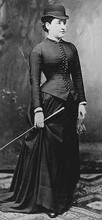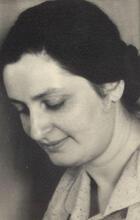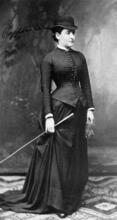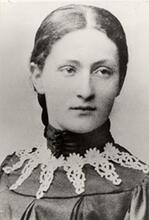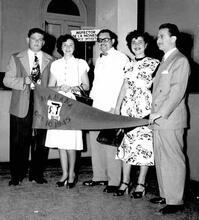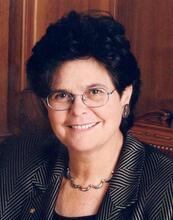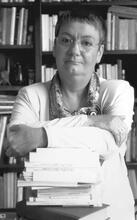Associazione Donne Ebree D'Italia (ADEI)
Article
The Association of Italian Jewish Women, or ADEI, was founded in 1927 in the city of Milan, Italy, home to the second largest Jewish community in the country. It is important to understand the social and political background in which ADEI came into existence and functioned for its first fifteen years. Already in the late nineteenth and early twentieth centuries, women’s voluntary organizations existed that dealt with welfare, education and, later, politics. These were liberal-bourgeois organizations, which embraced the cause of equal rights for women. Following World War I, during which women entered the labor force for the first time, these organizations fought for universal suffrage and for the opening of the labor market and the world of academe to women.
The accession of Mussolini in 1922 generated great hopes and expectations among the women’s organizations, owing to promises of reforms in the status of women; but these hopes quickly proved unfounded. Over the years, the new regime formulated a policy of discrimination against women which limited, among other things, their right to work. Women were considered important solely as childbearers and mothers; 1927 saw the launching of an intensive campaign to promote childbirth, which presented large families as contributing to the homeland and, consequently, as deserving of special benefits.
During the 1930s fascist state-sponsored women’s organizations were founded, displacing the liberal-bourgeois women’s groups, whose freedom of activity was promptly curtailed. Amidst these changes, a shift took place in the goals and modus operandi of most of the women’s organizations. With the departure of political struggle from their agenda, the original feminist ideology was also abandoned. In its place came a new concept, known as “Latin feminism,” which in effect sought to adapt feminism and the women’s organizations to the dictates of the fascist regime.
Accordingly, the remnants of the liberal organizations altered their approach during the 1930s, in the interests of survival. While the cultural activities (seminars, lectures and conferences) continued, the political struggle for equal rights began to lose its centrality. In its place, welfare activities took on greater importance and involvement in volunteer community work on behalf of the needy was stepped up under pressure from the authorities. This activity was presented as political action aimed at mobilizing the support of the masses. It was the fascist women’s organizations that shaped this pattern of activity, thereby rendering an important service to the government. In 1938, all women’s organizations that refused to undergo a process of “fascistization” were outlawed.
Against this backdrop ADEI emerged and carried out its work. The bulk of the Jewish population in Milan, where the organization was founded, were members of the upper socio-economic class, who lacked the proletarian roots of the venerable communities of Rome, Venice and Leghorn (Livorno). The idea of founding the organization originated with Berta Bernstein-Cammeo; with the help of several women led by Gabriella Falco-Ravenna and Vittoria Cantoni-Pisa, Susanna Gugenheim, Augusta Jarach and Marta Navarra-Bernstein, she endeavored to develop ties between the Jewish women of Italy and their sisters in Palestine. Following ADEI’s founding conference in 1927, four chapters were established in Milan, Turin, Genoa and Ferrara. In this context it is fitting to mention the names of Valeria Fubini of Turin, Rosa Pavia of Genoa, Wanda Bonifiglioli of Ferrara, Amelia Fano of Venice, Emma Benaim-Cantoni of Florence (Firenze), Alice Toaff of Leghorn and Emma Fano of Rome. Aided by local activists who spread the organization’s ideas to the women of their communities, the number of chapters nationwide rose in less than a decade to twenty-three and membership climbed from 117 (in 1927) to 1,334 (in 1937).
The goals of the organization, as established at the founding conference, focused on two major areas: strengthening and disseminating Jewish culture, and aiding the Jews of Italy, Palestine and Libya.
During the initial years of ADEI’s existence, the welfare work on behalf of the Jews of Libya took center stage; indeed, a special department headed by Marta Navarra (among the key figures in the entire organization) was founded for this purpose. The department succeeded in attracting donations also from those fascist Jews who did not, as a rule, offer financial support to activities with any Zionist bent. Welfare work in aid of the Jews of Italy was also considered extremely important and earned widespread support among Jews of all opinions. Over time, close ties were forged between ADEI and the welfare organizations of the various Jewish communities and even with the fascist welfare groups in the cities; as a result, it was possible to increase the assistance to impoverished families and widen the circle of activities to include vocational retraining for women.
In the mid–1930s ADEI took on several new spheres of activity that had customarily been the province of the fascist women’s organizations. Thus, for example, the Roman chapter of ADEI initiated home visits to needy families, an arrangement similar to the “Home-Visit Lady” of the fascist organizations.
As part of the welfare activities, clothing and household goods were collected for the needy. In addition, meat and milk were distributed to low-income families to supplement their diet. Other programs were carried out through a weekly sewing circle, where the women sewed and knitted clothing, blankets and related items that were delivered to the local needy or to Libya and Palestine. At a later point, these goods were sold at special sales, with the proceeds sent to these same destinations.
After 1933 ADEI became involved in aiding thousands of Jewish refugees who fled to Italy from states under German domination. These efforts expanded as the number of refugees increased over the years.
The organization’s other sphere of activity involved the promotion and dissemination of Jewish culture. This objective gained importance in light of the Riforma Gentile, an educational reform program launched in the 1920s which introduced Catholic studies into the curriculum of state schools. This led to an interest in encouraging Jewish youth to become acquainted with their own culture. In all the Jewish communities, ADEI organized groups for children and young people who had no other access to Jewish values and culture. In Milan, the organization’s members succeeded in introducing classes in Jewish studies for Jewish students in state schools. In the early 1930s ADEI initiated the publication of a special monthly for children, Israel dei ragazzi (Young People’s Israel), which included various sections dealing with Judaism and topics that appealed to a young audience. Parties were organized for mothers and children prior to Jewish holidays and a range of cultural programs were directed at women, including activity groups, Hebrew classes, lectures and various other activities.
Despite the Zionist nature of the organization it was decided early on not to establish official ties with WIZO (the Women’s International Zionist Organization) but to remain non-partisan, out of concern for the reaction of the fascist authorities. Consequently, the efforts on behalf of Palestine started out solely as welfare work, although they were inherently Zionist in nature. Activities carried out in conjunction with Zionist organizations such as Keren Kayemet le-Israel (the Jewish National Fund) and Keren Ha-Yesod were presented as welfare programs for the development of the Jewish community in Palestine. In 1931, in response to pressure from World WIZO, ADEI decided to join its ranks, becoming an official Zionist organization, although this fact was not publicized to avoid arousing the opposition of the authorities. Even so, ADEI was not unaffected by the fascist, totalitarian atmosphere that prevailed in Italy. In 1933–1934 there were increasing demands on the part of fascist circles within the Jewish community for the organization to adapt itself to the “spirit of the times” and refrain from ties with international Jewish organizations. In a number of communities the local chapter of ADEI was forced to call a halt to its activities as a result of mounting pressure from a fascist-oriented leadership. In 1935 ADEI came under the umbrella of the Union of Italian Jewish Communities and was forced to delete from its charter the articles associating it with activities on behalf of Palestine and the World WIZO organization. Despite the official change, Zionist activities were still conducted, albeit in an inconspicuous, even clandestine, manner.
In September 1938 antisemitic legislation was enacted that struck a serious blow to the Jews of Italy; among other things, Zionist activity of any sort was officially prohibited. Nevertheless, while all the non-fascist women’s organizations were declared illegal that year, ADEI continued to exist and to carry on with its vital welfare and cultural programs.
The antisemitic policies of the fascist regime nonetheless had an impact on the organization and its work. The first consequence was a drastic reduction in the number of members as a result of migration and the exodus from the communities. In April 1940 it was reported at ADEI’s General Assembly that the number of members had plummeted from 1,258 in 1938 to 689 only one year later. In the smaller communities this decline led to the closure of the local chapter. Concurrent with the drop in membership was a rise in the number of needy in the various communities, consisting of refugees and Italian Jews alike. In communities with large numbers of local poor, the bulk of the organization’s welfare activity was centered on aid to impoverished families. Members of ADEI in Rome, for example, organized a special fund to assist the families of peddlers who had been stripped of their peddling licenses in 1940–1941, causing their descent into an irreversible state of poverty. In other cities, primarily in the northern part of the state, the welfare work focused on the refugee population. The women of Milan, for example, organized soup kitchens, activity groups and aid stations for the refugees, dispatched financial assistance, and maintained contact with refugees who were transferred to detention camps scattered throughout the country.
Venice is an outstanding example of a chapter that actually stepped up its activities following the introduction of the racial laws. In April 1940 it was considered among the most active branches of ADEI, carrying out welfare work with the local poor and with refugees in the city and in the camps. In addition, the members of the organization assisted with educational activities at the Jewish school and even supported the reorganization of the local Jewish youth group.
ADEI’s work with refugees was carried out in cooperation with refugee-assistance groups in the various Jewish communities and later with national organizations: initially, with the Comitato di Assistenza agli Ebrei d’Italia, or COMASEBIT (the Committee to Assist Italian Jews, which operated from 1938 to 1939) and subsequently with the Delegazione per l’Assistenza agli Emigranti Ebrei - DELASEM (Delegation for the Assistance of Jewish Emigrants), which was launched in November 1939. Inter alia the women of the organization assisted in the running of hakhsharah training programs in preparation for Lit. "ascent." A "calling up" to the Torah during its reading in the synagogue.aliyah to Palestine, which operated in Italy until the summer of 1939. In all of the welfare efforts, whether with refugees or the local poor, it was evident that every chapter felt a common sense of urgency and obligation to continue its work in response to the growing need.
In 1938–1939, ADEI functioned under difficult circumstances due to constant tensions between itself and a number of leaders of the Union of Italian Jewish Communities, who demanded restraint coupled with abstention from Jewish “isolationist” activity of any sort. Accordingly, the organization’s members were obliged to switch to a pattern of semi-clandestine activity so as to avert an open confrontation with the leadership of Italian Jewry.
A change in the Union’s leadership in late 1939 led to a fundamental improvement in the situation and a fruitful collaboration with that body in serving the refugee population. The period from 1940 to 1943 was marked by intense activity, made possible in part thanks to the close, familial atmosphere in each of the chapters. In most cases the number of members was limited, allowing the organization to maintain sufficient flexibility to adapt itself to varying needs and constraints. Thus, for example, the members were able to discreetly organize activities dealing with “dangerous” topics that bordered on the subversive. Invitations to these meetings were relayed by hand rather than by mail so as to avoid censorship and exposure; many meetings were also held in the homes of members to escape the presence of party informants. Moreover, the organization was able to spontaneously initiate assorted programs such as a vocational retraining course for women about to emigrate.
The twofold objective of cultural identification and welfare assistance made it possible for ADEI to find various ways of carrying on with its activities even during times of economic hardship. For the members, enlisting in the cause offered the dual satisfaction of providing aid, on the one hand, and a framework with cultural substance, on the other.
During the period of German occupation and the Salo Republic (Repubblica Sociale Italiana, which existed from September 1943 until the end of the war) the organization was forced to cease operating. The women of ADEI, like the rest of Italian Jewry, were fighting to survive by going into hiding or fleeing to Switzerland. Some were captured by the fascists or the Nazis and deported to the death camps.
The process of rehabilitation following the liberation was not an easy one. In the smaller communities the number of Jews was greatly reduced as a result of deportations or the departure of congregants for other reasons. Nevertheless, it is evident that there was a supreme effort as early as the final months of 1944 and into 1945 to renew the full range of activities. The encounter with the soldiers of the Jewish Brigade revitalized the joint effort to assist the surviving remnant, conduct hakhsharah programs and organize aliyah. In the refugee camps set up throughout Italy ADEI encouraged the women refugees to join its ranks in order to increase the efficiency of its assistance work. A key figure in the rehabilitation process was Marta Navarra-Bernstein, who headed the organization from 1945 to 1963.
With the war over, ADEI could now openly proclaim its Zionist nature and acknowledge its close ties with World WIZO (indeed, in 1951, the name of the organization was officially changed to ADEI-WIZO). Aliyah activities, including aid and support for Aliyah Bet (organized “illegal” immigration to Palestine), thus took on major importance. In the spring of 1946, when the British intensified their monitoring of survivors arriving in Italy en route to Palestine, the local branch in Trieste was forced to submit to endless interrogations by British soldiers. One of the key personalities in the support effort, Anna Baruch (later president of the organization), openly confronted a British officer and protested the injustice of the White Paper and the detention camps in Cyprus. Her brave outcry resulted in her arrest and that of her husband; they were held for three weeks in a prison in Gorizia.
Since the establishment of Israel, ADEI has been especially active in providing aid to the state. Among its many activities are sending funds to support the needy, advancing the cause of cultural activities in Israel, encouraging aliyah and providing special assistance in wartime by sending medicines, clothing, money and the like. In 1958 WIZO Italy House, a clubhouse for young people, was set up in Tel Aviv-Jaffa, with the support of ADEI-WIZO, among others. Over the years, the clubhouse has turned into a full-fledged community center with a host of activities. The center is run, in part, by representatives of the organization who have immigrated to Israel, thus providing an ongoing connection between ADEI’s members in Israel and the various chapters in Italy.
Among the organization’s major activities are the annual group tours to Israel, which fulfill the dual purpose of bringing Italian Jews closer to Israel and to Judaism and, at the same time, expressing support for the Jewish state. In recent years the organization has initiated fundraising campaigns for victims of terrorist attacks in Israel.
Concurrently, ADEI has played an increasing role in cultural programs and welfare activities within Italy’s Jewish communities. Over the past several decades the organization has spearheaded a range of activities intended to deepen Italian Jewry’s familiarity with Jewish culture and the Hebrew language. Of particular importance is the effort to attract the more assimilated families, who do not have any contact with the Jewish community. Efforts aimed at the younger generation of mothers through a special program called Aviv - Giovane WIZO (Aviv - Young WIZO), founded in 1955, as well as programs for children, have intensified over the years and made it possible for ADEI to reach a broader Jewish audience. To these have been added a host of new projects, including the publication of books and pamphlets on Jewish subjects and the convening of special events, donation evenings and the like, all aimed at fulfilling the organization’s objectives: welfare assistance, dissemination of Zionism and Jewish culture, and the advancement of women—a goal that has gained momentum in recent years. Between 1953 and 1960 the organization published La Nostra Rivista (Our monthly magazine), edited by Sisa Lopez. Since 1975 ADEI has published a newsletter, Il Portavoce (The spokesman), which has become a major sounding board for the organization, under the joint editorship of Carla Falk and Costanza Palagi. During the 1970s a special children’s newspaper, Il Giornale Per Noi (The newspaper for us), was also put out, as a means of exposing the younger generation to various topics related to Judaism and Zionism.
The demographic trends that characterize many Lit. (Greek) "dispersion." The Jewish community, and its areas of residence, outside Erez Israel.Diaspora communities, including a decline in size due to extremely high rates of assimilation coupled with the aging of the Jewish population, are confronting ADEI-WIZO with serious challenges. Yet the organization, which on the whole has remained small and flexible, is still capable of adapting itself to changing circumstances and formulating new projects as the need arises.
Presidents of ADEI (by year)
1927–1928 Berta Bernstein-Cammeo
1928–1939 Vittoria Cantoni-Pisa
1939–1945 Gabriella Falco-Ravenna
1945–1963 Marta Navarra-Bernstein
1964–1976 Anna Baruch-Senatti
1976–1985 Bianca Finzi-Colbi
1985–1989 Adelina Pinto-DellaPergola
1989–1998 Zita de Ciaves-Arditi
1989–1998 Rina Lattes-Fiano
1998– Ziva Modiano Fisher
1998– Berta Sinai
SELECTED BIBLIOGRAPHY
ADEI-WIZO from Its Founding to the Present (Italian). Venezia: 1971; ADEI WIZO, 1970–1997 (Italian). Varese: 1998; De Grazia, Victoria. Women in a Fascist Regime (Italian). Venezia: 1993.

